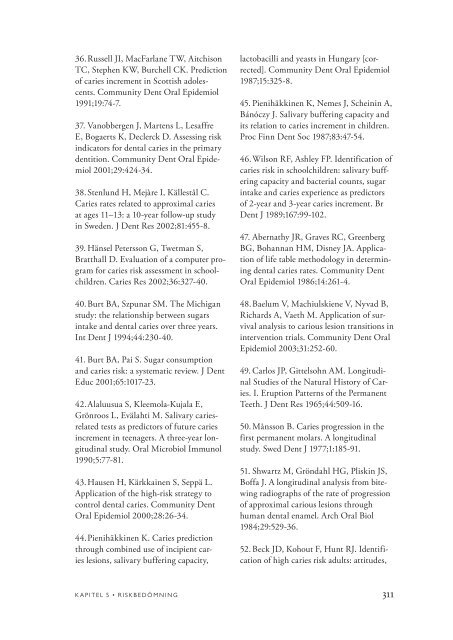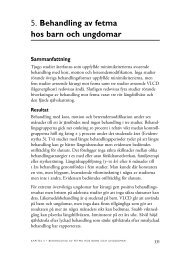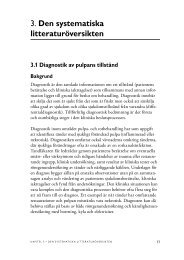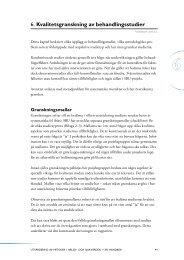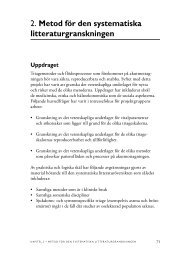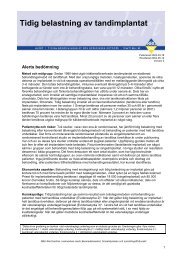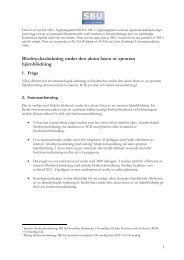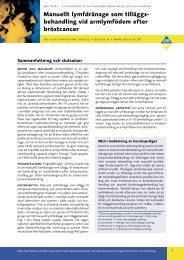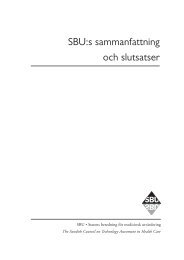Fulltext - SBU
Fulltext - SBU
Fulltext - SBU
You also want an ePaper? Increase the reach of your titles
YUMPU automatically turns print PDFs into web optimized ePapers that Google loves.
36. Russell JI, MacFarlane TW, Aitchison<br />
TC, Stephen KW, Burchell CK. Prediction<br />
of caries increment in Scottish adolescents.<br />
Community Dent Oral Epidemiol<br />
1991;19:74-7.<br />
37. Vanobbergen J, Martens L, Lesaffre<br />
E, Bogaerts K, Declerck D. Assessing risk<br />
indicators for dental caries in the primary<br />
dentition. Community Dent Oral Epidemiol<br />
2001;29:424-34.<br />
38. Stenlund H, Mejàre I, Källestål C.<br />
Caries rates related to approximal caries<br />
at ages 11–13: a 10-year follow-up study<br />
in Sweden. J Dent Res 2002;81:455-8.<br />
39. Hänsel Petersson G, Twetman S,<br />
Bratthall D. Evaluation of a computer program<br />
for caries risk assessment in schoolchildren.<br />
Caries Res 2002;36:327-40.<br />
40. Burt BA, Szpunar SM. The Michigan<br />
study: the relationship between sugars<br />
intake and dental caries over three years.<br />
Int Dent J 1994;44:230-40.<br />
41. Burt BA, Pai S. Sugar consumption<br />
and caries risk: a systematic review. J Dent<br />
Educ 2001;65:1017-23.<br />
42. Alaluusua S, Kleemola-Kujala E,<br />
Grönroos L, Evälahti M. Salivary cariesrelated<br />
tests as predictors of future caries<br />
increment in teenagers. A three-year longitudinal<br />
study. Oral Microbiol Immunol<br />
1990;5:77-81.<br />
43. Hausen H, Kärkkainen S, Seppä L.<br />
Application of the high-risk strategy to<br />
control dental caries. Community Dent<br />
Oral Epidemiol 2000;28:26-34.<br />
44. Pienihäkkinen K. Caries prediction<br />
through combined use of incipient caries<br />
lesions, salivary buffering capacity,<br />
lactobacilli and yeasts in Hungary [corrected].<br />
Community Dent Oral Epidemiol<br />
1987;15:325-8.<br />
45. Pienihäkkinen K, Nemes J, Scheinin A,<br />
Bánóczy J. Salivary buffering capacity and<br />
its relation to caries increment in children.<br />
Proc Finn Dent Soc 1987;83:47-54.<br />
46. Wilson RF, Ashley FP. Identification of<br />
caries risk in schoolchildren: salivary buffering<br />
capacity and bacterial counts, sugar<br />
intake and caries experience as predictors<br />
of 2-year and 3-year caries increment. Br<br />
Dent J 1989;167:99-102.<br />
47. Abernathy JR, Graves RC, Greenberg<br />
BG, Bohannan HM, Disney JA. Application<br />
of life table methodology in determining<br />
dental caries rates. Community Dent<br />
Oral Epidemiol 1986;14:261-4.<br />
48. Baelum V, Machiulskiene V, Nyvad B,<br />
Richards A, Vaeth M. Application of survival<br />
analysis to carious lesion transitions in<br />
intervention trials. Community Dent Oral<br />
Epidemiol 2003;31:252-60.<br />
49. Carlos JP, Gittelsohn AM. Longitudinal<br />
Studies of the Natural History of Caries.<br />
I. Eruption Patterns of the Permanent<br />
Teeth. J Dent Res 1965;44:509-16.<br />
50. Månsson B. Caries progression in the<br />
first permanent molars. A longitudinal<br />
study. Swed Dent J 1977;1:185-91.<br />
51. Shwartz M, Gröndahl HG, Pliskin JS,<br />
Boffa J. A longitudinal analysis from bitewing<br />
radiographs of the rate of progression<br />
of approximal carious lesions through<br />
human dental enamel. Arch Oral Biol<br />
1984;29:529-36.<br />
52. Beck JD, Kohout F, Hunt RJ. Identification<br />
of high caries risk adults: attitudes,<br />
KAPITEL 5 • Riskbedömning<br />
311


